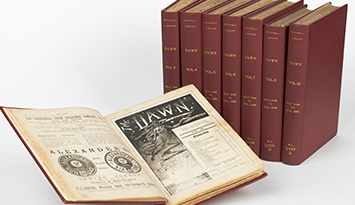Issue 104
Term 1 2018
Bringing history to life
The National Film and Sound Archive provides access to a wide range of audiovisual content to help bring history to life.
With knowledge more obtainable than ever, educators have countless options to stimulate their students’ curiosity. New generations are digital natives, immersed in media 24/7. High-quality audiovisual resources have become increasingly important tools to inspire students. With more than 2.8 million items in its collection, the National Film and Sound Archive (NFSA) is the custodian of Australia’s audiovisual history. It is also a rich source for the classroom, with an increased amount of interesting, freely available content on the new website.
Besides accessible digital educational resources and teachers’ notes in its Learning section, the website also has a wealth of material that can be viewed and enjoyed via online exhibitions, curated collections, and its Australian screen website. The latter was created in partnership with Education Services Australia and features clips that were selected for their educational value, accompanied by teachers’ notes from specialist curriculum writers.
The NFSA Education Manager, Cris Kennedy, cites Film Australia Collection as one of the best resources for educators. It includes more than 3,000 documentaries and docu-dramas that were commissioned by the federal government between 1913 and 2008.
With an aim of producing an audiovisual record of Australian life, the collection includes the arts, history, the environment, science, Indigenous studies, immigration, war, and politics — with specific topics such as the story of the ANZACs, the life of Eddie Mabo, the importance of the wool industry, and even the history of cane toads.
One of the best things about this collection is that it is a great way to teach the difference between primary and secondary sources. In recounting real-life occurrences, many of these films include first-hand accounts, photographs, footage and audio.
‘Being able to comprehend the value of primary and secondary sources is in the curriculum from grades 4 through to 8, with increasing complexity’, says Kennedy. ‘It’s a really good thing for students to go beyond Wikipedia and think about the value of these kinds of sources.’
Not only are clips from the collection available on the NFSA website and YouTube channel, but schools are also able to acquire DVDs and Blu-rays via the NFSA’s worldwide distribution service. Many of the titles also come with study guides that can be downloaded for free from the NFSA shop.
Across primary and secondary levels, there are a number of programs to choose from, covering areas such as Indigenous representation on screen, Australia at war, and the history of advertising in Australia.
‘We want to be a support for teachers’, says Kennedy. ‘We know our collection and can help you to use it as a teaching tool.’
However, that doesn’t mean these sessions are simply a matter of hitting ‘play’ on a selection of clips. As every teacher will know, it takes more than that to catch the attention of young minds.
‘Kids are more engaged when there’s a way to interact with the clips’, Kennedy says. ‘We ask them to pick apart what they’ve seen, encourage them to ask questions. The aim is to be the start of a big conversation that can carry over to the classroom.’
Cris Kennedy believes that the glimpses into the past offered by the NFSA’s resources are an exciting way to experience history holistically.
‘It’s not just about what happened. You get to see what things were like when they happened’, he says. ‘What people were wearing, how they lived … You can see first-hand what those times were like — and it will give your students a more in-depth knowledge than a list of facts ever would.’
